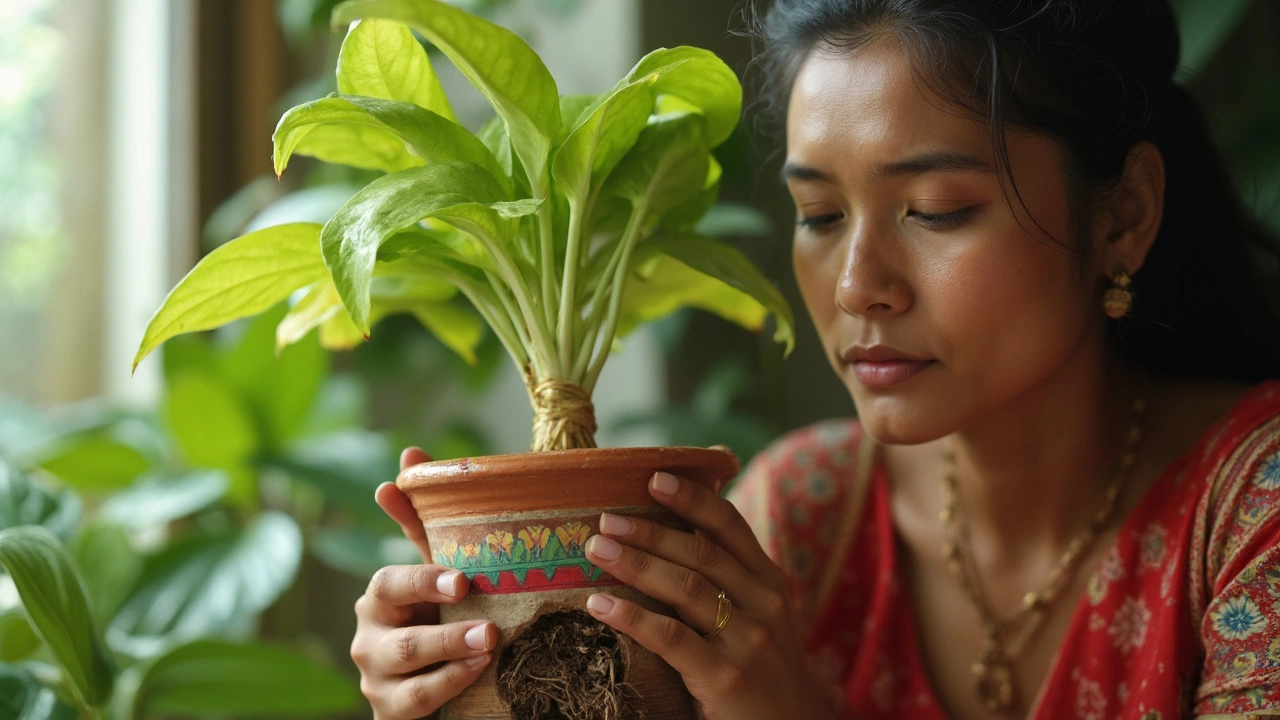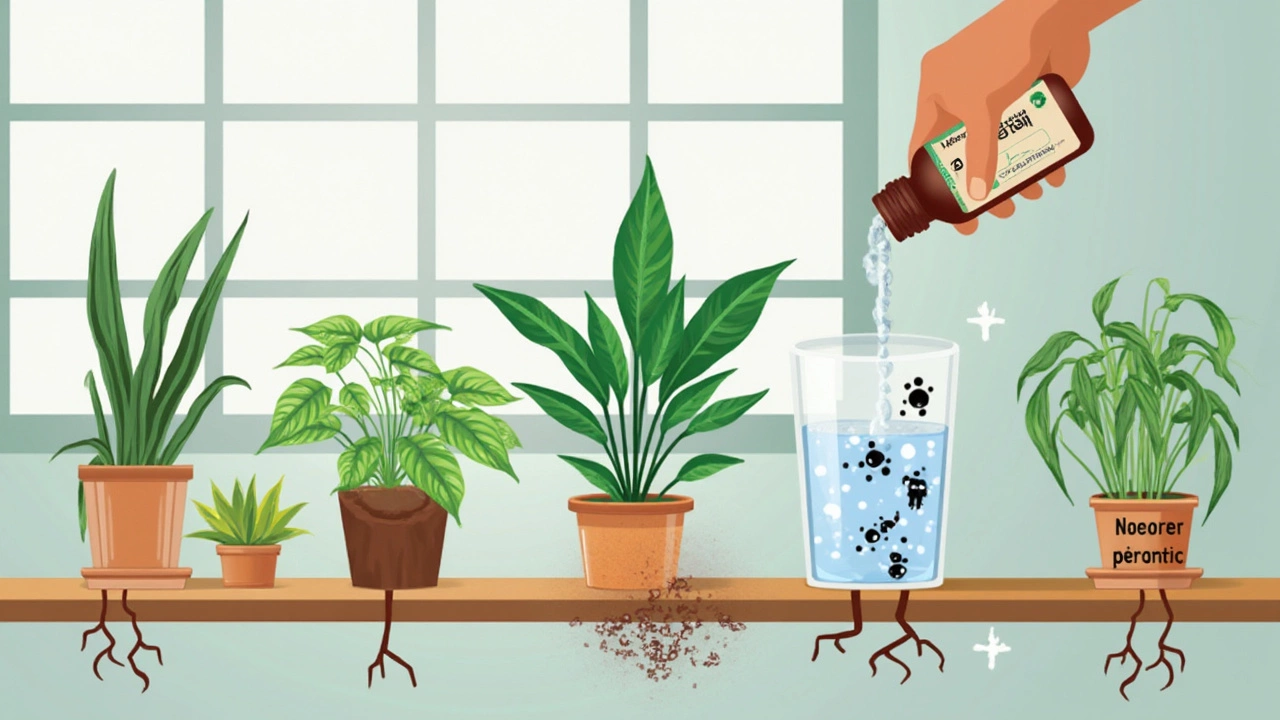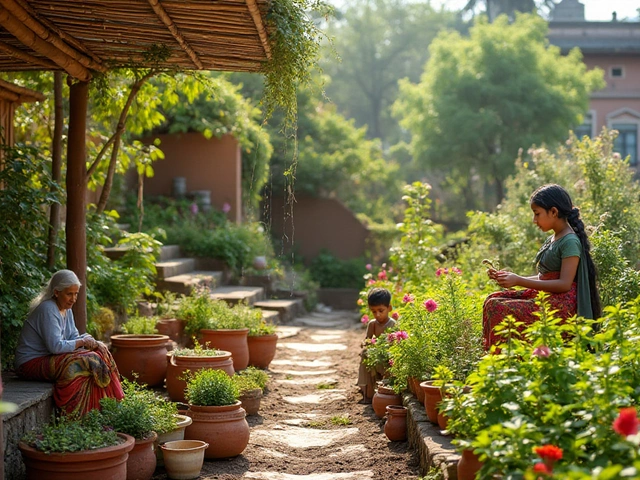Does Hydrogen Peroxide Help Root Rot? The Real Story for Indoor Plants

Does Hydrogen Peroxide Help Root Rot? The Real Story for Indoor Plants
Root rot can sneak up on your favorite plant fast. You water like you’re supposed to, but then, out of nowhere, the leaves flop and the roots turn mushy. If you’ve ever read about spraying or soaking with hydrogen peroxide, you’re definitely not alone. Tons of houseplant owners have tried it, hoping for a miracle cure.
The deal is, hydrogen peroxide isn’t just for first aid kits. The bubbly stuff breaks down into water and oxygen, and that extra oxygen can potentially kill off some of the bad guys causing rot. So, is it really as easy as mixing a bit with water and pouring it on your plants? Not quite. Using it the wrong way can actually do more harm than good.
- Root Rot: What It Looks Like and Why It Happens
- How Hydrogen Peroxide Works Against Root Rot
- How to Safely Use Hydrogen Peroxide on Indoor Plants
- Mistakes to Avoid and Better Long-Term Solutions
Root Rot: What It Looks Like and Why It Happens
If you’ve ever pulled a plant out of its pot and noticed black, soggy roots with a nasty smell, you’ve seen root rot up close. The first sign usually starts above the soil—leaves droop or turn yellow, even when you haven't forgotten to water. Sometimes they get soft or fall off way too easy. Dig down and you’ll find roots that look more like cooked spaghetti than the healthy, crisp strands you want.
This mess happens when the soil stays wet for too long, giving nasty fungi and bacteria a place to party. The usual suspects are overwatering, poor drainage, and pots with no holes. These conditions cause oxygen to vanish from the soil, suffocating roots while letting root rot pathogens take over. The most common troublemakers are fungi like Pythium, Phytophthora, and Fusarium.
Want to know why some houseplants seem doomed, even with the same care as others? Different species have quirks about how much water they like. A cactus or succulent in soggy soil can get root rot much faster than a tropical pothos.
- Healthy roots: firm, white, and smell earthy
- Rotted roots: mushy, brown/black, and smell awful
Root rot is sneaky—by the time your plant looks sad, the damage underground is usually well underway. That’s why catching it early is a lifesaver. Knowing what root rot looks and smells like makes all the difference for your indoor plants.
How Hydrogen Peroxide Works Against Root Rot
So, what’s actually happening when you use hydrogen peroxide for root rot? It all comes down to chemistry. Straight from the bottle, hydrogen peroxide (that’s H2O2 if we’re getting technical) looks a lot like water, but it has an extra oxygen atom. That matters, because when you mix it with water or pour it on soil, it breaks down and releases oxygen right where your plant roots are struggling.
Why does the extra oxygen help? Most of the bacteria and fungi that cause root rot—like Pythium and Phytophthora—thrive in wet, low-oxygen soils. They basically attack roots that are already suffocating. When you add hydrogen peroxide, you pump more oxygen into the mix, making things less cozy for the rot-causers. At the same time, healthy roots that were starving for air can bounce back.
There’s also the fizz—everyone loves seeing those bubbles. That’s a sign the hydrogen peroxide is killing off germs and breaking down dead, mushy root bits. Scientists actually use it in labs to sterilize tools and surfaces, so it’s no surprise it helps kill off some baddies in soil, too.
| Problem | How Hydrogen Peroxide Helps |
|---|---|
| Low oxygen in soil | Adds direct oxygen to roots |
| Fungi & bacteria buildup | Disinfects and kills pathogens |
| Mushy, dead roots | Breaks them down faster |
The bottom line: a diluted dose of hydrogen peroxide can sometimes clear up a mild case of root rot by boosting oxygen and knocking out some germs. But it works best if you catch the problem early—once the roots are really gone, hydrogen peroxide can’t bring them back. And if you get carried away with dosing, you could end up stressing your plant even more.

How to Safely Use Hydrogen Peroxide on Indoor Plants
If you’re thinking about using hydrogen peroxide to tackle root rot, don’t just dump it straight from the bottle. Too strong, and you’ll end up burning the roots. You want the common 3% hydrogen peroxide you find at the pharmacy—not the higher concentrations used for hair dye or cleaning.
The golden rule is to dilute it first. Most plant owners stick with a mix of one part 3% hydrogen peroxide to three parts water. That usually means, if you’ve got one cup of peroxide, add it to three cups of water. This creates enough kick to help without frying your plant's roots.
- Remove the plant from the pot and rinse the roots gently to get rid of soggy or dead bits. Use clean scissors (wipe them with a little hydrogen peroxide too).
- Soak the healthy roots in your diluted peroxide mix for about 5–10 minutes. You’ll see bubbles, and that’s the oxygen going to work on bacteria and fungi.
- Let the roots air dry for a few minutes before replanting in fresh, well-draining soil. Never stuff the roots back into the same wet, infected dirt.
For plants you don’t want to unpot, you can try watering the soil with your diluted hydrogen peroxide solution once every week or two—never more often—until you see recovery. Don’t let the soil get soggy afterward, or you’ll risk making root rot worse.
Here’s a simple reference if you want to double-check your mix. This method is what most plant hobbyists talk about online:
| Hydrogen Peroxide | Water | Frequency |
|---|---|---|
| 1 cup (3% solution) | 3 cups | Once every 1-2 weeks |
Always make sure your indoor plants are in pots with drainage holes. That’s how you stop root rot from coming back, way more than just using peroxide.
Mistakes to Avoid and Better Long-Term Solutions
Before you grab the hydrogen peroxide every time something looks wrong, let’s slow down. One of the biggest mistakes people make is thinking they can just keep pouring it on. That doesn’t fix the root cause—overwatering. If you ignore that step, your plant is in for trouble no matter how many times you treat it.
Another common slip-up is using straight-up hydrogen peroxide without diluting it. Full-strength stuff will flat-out burn your healthy roots. Always dilute: a good rule is one tablespoon of 3% hydrogen peroxide in a quart of water. If you’re winging it, you’re risking more damage than good.
The soil you use matters, too. Heavy, dense potting mixes hold too much water, trapping moisture by the roots and making root rot more likely. Use a chunky, well-draining mix designed for your specific houseplant. Repotting into fresh soil lets your plant breathe and bounces back faster.
Here’s a checklist to stay on track with long-term solutions—not just quick fixes:
- Check pots for drainage holes. No hole? You’re just asking for soggy roots.
- Water only when the top 1-2 inches of soil feels dry, not just on schedule.
- Keep an eye on humidity and airflow. Fungal spores love stale, damp air.
- Remove dead roots with sterile scissors every time you repot, so pathogens don’t spread.
- Use clean tools. Dirty ones spread disease faster than you might think.
To show how much switching up these habits helps, check this data pulled from plant forums and care guides:
| Cause of Root Rot | Chance of Recurrence (if not fixed) |
|---|---|
| Poor drainage | 65% |
| Improper watering | 60% |
| Contaminated tools | 40% |
The bottom line: hydrogen peroxide is a tool, but it can’t build lasting plant health by itself. Focus on better watering habits, soil, and pot choice. These fixes keep problems from popping back up and keep your indoor plants thriving for the long haul.
About
Gardener Support India is your go-to online destination for expert advice on gardening and horticultural services in India. Whether you're a beginner or an experienced gardener, our platform offers extensive resources, tips, and support tailored to Indian climates and plant species. Explore a wide range of guides on plant care, sustainable gardening practices, and innovative gardening solutions. Connect with local experts to enhance your gardening experience and maintain a flourishing garden. Our dedicated services aim to empower Indian gardeners with the knowledge and tools needed for a successful gardening journey.
Latest Posts


Why Tomato Is Costly in India?
By Alden Thorne Nov 11, 2025

Essential Terrace Protection Techniques for Thriving Gardens
By Alden Thorne Jan 2, 2025

Top Plants for a Sustainable Garden: Eco-Friendly Choices That Thrive
By Alden Thorne Jul 6, 2025

Write a comment